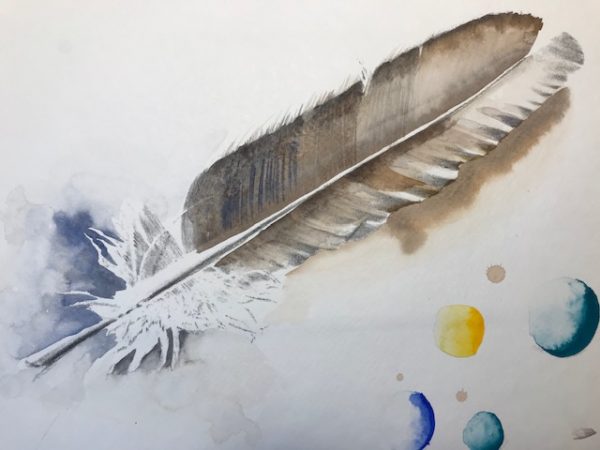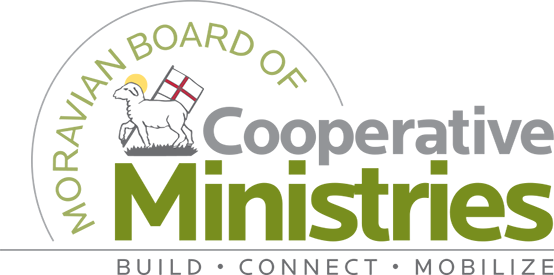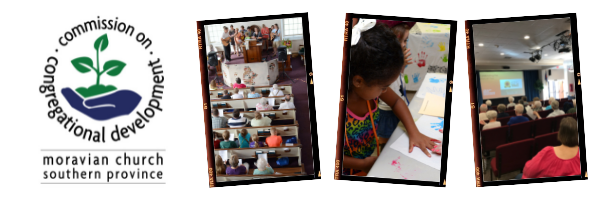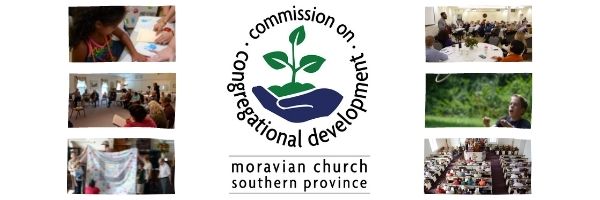
BY WILLIAM NEEDS |
Note: This is part of a monthly blog series, “Coffee with Moravian Ancestors.” Bill sits down with important figures in the Moravian church to have a cup of (Moravian) coffee, asking questions about his or her life and how they have impacted the church! Look for Bill’s other blog posts here. To accompany his blog posts, he has drawn the images from his trip to Europe on the Roots of the Moravian Church Tour. For more art, visit Bill’s website at BillNeeds.com.
__________________________
Shekemeko was an inconspicuous Mahican village nestled between the Hudson River and Berkshire Mountains on the Connecticut border in upper New York state. When the Mahican Tribe encountered colonists settling on their land, they sent a delegation to New York City in 1740 to negotiate a settlement.
Bishop Spangenberg heard of their plight and sent Christian Henry Rauch to meet and introduce that delegation to the Moravian Brethren and their mission to native peoples. This introduction began a long-lasting relationship between the Moravian Brethren and the Delaware Nation, which extended to the “Confederation of Six Nations” – a democratic union established among native chiefs to protect and defend against European encroachment (a concept later proposed by Benjamin Franklin).
Two years later, Shekemeko had become a congregation of Mahican Christians. Nurtured by Moravian missionaries from Bethlehem, Pennsylvania, they received Christian education but also advice to avoid being cheated and to avoid illegally sold alcohol. As the mission’s reputation spread along the banks of the Hudson, Schkemeko’s native population grew, threatening settlers living nearby.
Only 100 miles away, New York City experienced serious slave unrest and insurrection in 1741. “The City” then had a slave population second only to Charleston, SC. Missionaries were viewed with suspicion of interfering with colonial fortunes if not actually inciting insurrection. Fearful settlers insisted local authorities take action. Moravian missionaries were detained, interrogated, and fined only to be released to continue their work.
Resentment swelled into a movement plotting against the Shekemeko mission. In 1744, authorities enacted a law requiring anyone living among Indians to pledge a vow to the Crown and to be licensed by the Governor. Vow-taking was against Moravian religious principles so, when the missionaries refused to comply, the governor ordered them to “desist from further teaching and depart the province.”
The mission remained active so settlers resorted to one ultimate petition. In 1746 they asked the governor to issue hunting licenses authorizing the killing of Shekemeko Indians. Although the petition was never fulfilled, the call for extermination struck fear among the Mahicans. Converts dispersed and Shekemeko was abandoned; some scattered into nearby Connecticut, 44 converts fled to Bethlehem, PA in April 1746.
Coffee with David Zeisberger 1721-1808
Q. Brother David, you have a reputation of having brought Christ to natives in the American wilderness. Would you explain how that came about?
A. Like many other missionaries from Herrnhut, we shared similar backgrounds: flight from persecution in Moravia, faith deepened in Germany, then a mutual calling to journey into unknown parts of the world to tell those who had never heard about the love of God through Jesus.
I remained in Herrnhut under the loving care and instruction of a Choir while my parents served in Savannah as early missionaries. I was invited to join them when it was safe.
Life as a teenager on the frontier of a foreign country was exciting. Developing friendships with natives. I admired their peaceable culture with close-knit families and community living in harmony with all aspects of nature; unlike Europeans who seem obsessed with individual desire to subdue or dominate nature.
On the other hand, Indians admired European technology: we harness the wind to move huge boats; cook our food with tools and pots forged out of metal; hunt wildlife using gunpowder; make music with instruments shaped from shiny brass. We tame horses and oxen to work our farms and to move along forest paths. You can’t bridle or ride a deer.
I think they respected us, and feared us, for our ability to capture natural forces rather than simply live in harmony with nature.
Q. Those are interesting insights. Did these influence you in later years?
A. Of course! My adult life was spent learning about them while respectfully teaching them about us. What they didn’t have was knowledge of a redeeming God and words to understand their need for personal redemption.
When it was decided the mission in Savannah should be terminated, our family moved from Georgia to Pennsylvania. I was accustomed to speaking native languages so I studied linguistics at a Moravian school in Bethlehem. Upon graduation, I became an interpreter for Moravian missionaries.
I accompanied Christian Post in 1744 to visit the Mahican Indians in Shekemeko, a visit that became memorable because I celebrated my 23rd birthday in prison following an arrest on fabricated charges. In 1746 I joined Bishop Spangenberg in Syracuse NY to participate in discussions with the Six Chiefs of the Iroquois Confederacy; also memorable for finalizing agreements begun by Zinzendorf in 1742 which allowed Moravian missionaries to move freely through all “Indian lands.”
I helped establish a mission village for Mahican refugees when they arrived from Shekemeko. That village only 30 miles from Bethlehem was named Gnadenhütten (in English, “Tents of Grace”). When Delaware tribes were relocated, I took another contingent of converts further west to establish a new mission called Shamokin.
Q. So your work with the Moravians began as an interpreter. How did you make that leap to become a missionary?
A. Establishing Gnadenhütten in 1747 and Shamokin in 1749 marked the beginning of my ministry. I was ordained when I turned 27 and, moved by Zinzendorf’s charge that all missionaries should find their own way to tell the story about Jesus, my words about Christ became my own rather than translations.
It was important to provide a safe environment for effective interaction. We sit here, today, having a calm conversation over a cup of coffee. Likewise, mission stations were established to offer sanctuary in the wilderness where a conversation might occur, where the story could be shared.
Inevitably, our missionary purpose became controversial. Because missionaries came to give instruction to the natives, colonists came to take their land by purchase, or trade, or force, it was inevitable that our intentions would clash. Diaries of my work in America were notes of accomplishment separated by moments of violence.
For example, it was evening November 24, 1755, when sixteen mission workers gathered for supper in Gnadenhütten. Most converts had moved across the river into a newer village. I had just arrived when I heard shouting from across the river. I was horrified to see the mission house being attacked and burned down by hostile “Indians.” There was no way to help. Only five survived. Those who did not die in the fire were shot with weapons given by the French.

Q. I don’t understand why Indians were stirred to violence by the French. Would you explain?
A. The French and Indian War was really an extension of Europe’s 7 Years’ War – a conflict between the governments of England and France using American soil as a battleground. France recruited Indian allies as foot soldiers in that war.
One must realize that Natives had lived in America unmolested for 10,000 years. The arrival of European immigrants brought theft of their land and assault on their way of life. Natives concluded their survival would depend upon creating alliances with the least hostile Europeans. French traders had been “business partners” to Indians in the Ohio territory since the 1600’s so they seemed to be a likely ally.
In 1749 England established The Ohio Company to promote trade and English settlements which threatened the peace in the Ohio Valley. Frenchmen called up Indian allies to help protect their mutual interests and Indians complied, effectively using stalking and hunting methods to combat British forces. British soldiers not trained in guerrilla tactics found the rules of engagement had changed dramatically.
The murder of eleven Moravian missionaries was an unintentional escalation of guerrilla tactics during the French and Indian War. I was certain the safety of mission villages could not be assured.
Q. Did the Moravians from Bethlehem do anything to protect Indian converts?
A. We moved converts from Gnadenhütten and Shamokin to new missions of Nain and Wechquetank, closer to Bethlehem. However, the presence of Natives in such close proximity to white settlements and farmers fanned resentment. It became obvious this could not be a permanent solution.
During the entire course of my life, my ministry to the Indians on America’s frontier would be buffeted by the climate of mob threats, violence, and terrorism:
- Ending of the French and Indian War (1756-1763), Indians were forced to negotiate terms with the victorious British;
- Pontiac’s Uprising (1763-1765) was settled by treaties that were negotiated with malicious intent, and often broken;
- The Revolutionary War (1776-1783) ended with Indians forced again to renegotiate new treaties with victorious and suspicious Americans;
- The Indian Wars (1783-1900) became a violent response in Ohio to decades of abuse of Indian rights and values
- Indian Relocation (1900-1905) General Washington’s Treaty forced tribes from their traditional lands in Ohio to allow settlers free expansion into the Ohio territory.
Each episode of violence seemed to unite colonists into “mob mentality” promoting Indian hatred. Moravian missions to the American Indian are woven into the history of hostility provoked by Chief Pontiac.
Q. Pontiac’s Uprising? Exactly what was that and how did it impact Moravian missions?
A. Pontiac was an Ottawa Chief living near Detroit who resisted the ultimatum requiring he accept British occupation on his land as a condition for peace. In May 1763 he led 300 warriors to attack Fort Detroit. That attack failed but, when Pontiac laid siege to the fort, he was joined by 900 Delaware and Shawnee warriors.
Word of Pontiac’s courageous stand spread throughout the wilderness, inciting tribes to rise up against the British. Forts were attacked, settlements destroyed, colonists were killed. This became the first effective resistance of Indian tribes to the continuous flood of Europeans into America.
Native converts near Bethlehem were threatened by angry mobs, so were moved again into more secure quarters in Philadelphia provided by Governor Penn.
Q. How did the Moravians missionaries manage to continue work under such adverse conditions?
A. Moravian leaders in Bethlehem consulted with a respected Munsee medicine man, diplomat, and Moravian convert named Papunhank to redesign their mission strategy. It was decided missions should remain, as much as possible, in Indian villages led by native converts, called helpers. Helpers would assure familiar protocols and lifestyles would be maintained in which missionaries would live and serve, rather than creating villages for Europeans with a limited number of converts. In 1766, with the assistance of Papunhank, I gathered the Mahican converts from their Philadelphia refuge to trek 150 miles to establish a mission village named Friedenshutten, near the New York border.
Two years passed, Friedenshutten grew as a prosperous and welcoming village, but peace would not last long. Another treaty was enacted (Treaty of Fort Stanwix) with which the Confederation of Six Nations sold out this prosperous Munsee-Mohechan village to white settlers forcing another departure 300 miles westward to the Beaver River. Here, at the headwaters of the Allegheny River (near present-day New Castle and 20 miles east of Youngstown Ohio) I established a base from which a series of missions were developed during the next four years.
Here, I also encountered a new type of resistance from tribal leaders. Although the Christian message was generally accepted to Indians because their culture revered a loving Creator, they argued that accepting Christ removed members from the tribe and weakened their fragile culture.
Q. This concern seems understandable. How did you explain your motives to the chiefs?
A. I tried to explain I had only one goal, as outlined by Zinzendorf; to go live among the heathen. Silently observed to see if any were prepared, by the Grace of God, to receive the Word of Life. Then, even if only one were found, take him or her aside and teach, knowing that God alone will give ears to hear and a heart open to receive the Gospel.
I can’t say that this explanation was satisfactory, but one Delaware chief named Netawatwas insisted that we come to his village in Ohio.
Q. How was Chief Netawatwas different from other tribal chiefs?
A. Chief Netawatwas had visited Friedenshutten in 1766. Impressed with the educational and spiritual benefits of Moravian missions, he sent numerous requests for me to come to his new village in Ohio with converts.
In May 1771, canoes were loaded with cargo and 11 Delaware converts, paddled downriver past Fort Pitt into the Ohio River to present-day Marietta, then up the Muskingum River to the Delaware capitol village of Goschachgunk, (present-day Coshocton on the Tuscarawas River).
Schoenbrunn (English: Beautiful Spring) was staked out 30 miles upstream on an elegant wooded rise. That fall, other converts arrived from Friedenshutten to begin a second mission downriver and named Gnadenhütten in memory of the fallen mission in Pennsylvania.
Both missions were laid out with German symmetry and became a blend of Native and European cultures with schools, church buildings, homes with fertile gardens, and abundant freshwater. In 3 years Gnadenhütten and Schoenbrunn grew to exceed 400 converts. Bethlehem sent missionaries and other mission stations were added. One named Lichtenau was only 2 miles away from the Delaware capital, a convenient walk or paddle to hear the daily reading of the Word of God. Boundaries of Lichenau were staked out in April 1776 as Netawatwas looked on, oblivious to changes that this year would bring to our world.
Three months later, 10 years of relative peace came to an end when patriots, weary from England’s taxation, dramatically broke away from Britain’s rule. It became obvious that a Revolutionary War would not be confined to the east coast when in September 6,000 colonial troops from Virginia and the Carolinas destroyed thirty-six Cherokee towns. Chief Netawatwas died in October, precisely when strong leadership was needed to maintain Delaware autonomy in middle Ohio.
Q. How did the death of Netawatwas affect the development of missions, especially at a time of new political turmoil?
A. The Revolutionary War began with military clashes in the East. England calculated an increased military presence in the Ohio territory would draw Washington’s army to the West. The lieutenant governor in Detroit was ordered to enlist Native warriors to augment his meager British battalion. Most tribes along the Great Lakes and Mississippi River committed to the British cause, but the new Delaware chief chose a path of neutrality prompted by pacifist Moravian beliefs.
Located on the “warpath” between British forces in Detroit and American forces in Pittsburgh, our villages offered food and housing to all war parties passing through regardless of which side they represented. Meanwhile, I continued sending regular mission status reports to Bethlehem. Dispatched through Fort Pitt which was controlled by the colonials since 1772, I was unaware that my practice of reporting to Bethlehem would be suspected as an act of espionage.
Conditions around our missions became increasingly dangerous, so much so that in 1777 I arranged evacuation from Schoenbrunn and Gnadenhütten to consolidate all converts in Lichtenau. I later came to regret my decision when I found myself sucked into a flurry of political speculation. In time the Delaware Council decided to side with the British.
Lichtenau’s close proximity to the Delaware tribal capitol compromised our appearance of neutrality so, in 1780, we abandoned Lichtenau to return upriver to Gnadenhütten. This decision was timely. Lichtenau was destroyed by colonial raiders and the Delaware chief forced into exile.
Q. Keeping mission stations “neutral” sounds like a very tricky position to maintain. How did you manage this?
A. Neither British nor American colonists fully believed our declarations of neutrality. When a new British commander was assigned to Detroit’s fort in 1781, he was approached by an ambitious Wyandot Chief who convinced him that Moravian missionaries on the Muskingum River were actually spies for the Colonial Army.
In August 1781, 300 Wyandot warriors carrying the British flag arrived at our mission villages to arrest Moravian missionaries for treason and retain 400 converts on charges of conspiracy. All were marched to Sandusky in September, leaving 5,000 bushels of grain to rot in the farmland while we awaited trial in Detroit.
When the trial convened in November, the Wyandot witnesses who had brought charges against the Moravian missionaries changed their story and admitted lying. The agitated commander found us innocent of all charges. Free to leave Sandusky, we were unable to begin our return trip due to the early arrival of harsh winter weather. As grain ran out, converts left in small groups in search of food for their families: in January 1782, 150 converts foraged among Shawnee villages and begged at sugar camps; in February 100 left Sandusky hoping to safely reach the mission villages.
Then in March we who remained in Sandusky were preparing to return to our villages when a messenger arrived with an urgent request that all Moravian missionaries return immediately to Detroit. Reluctantly I complied, sending most converts to return to the missions without me.
Q. The intrigue continues. Why were you ordered to return to Detroit after enduring a long winter near starvation in temporary quarters?
A. Another delay! I was annoyed but unaware the commander had received word that a militia was organizing in western Pennsylvania to march on Indian villages along the Muskingum to avenge a February Indian raid and murder of a family settled on Indian land. Had we returned to the Muskingum as planned, we would have walked into a massacre.
On March 8, 1782, the armed militia arrived in Gnadenhütten to be welcomed, as usual, by converts who had previously returned from Sandusky. The raiders suddenly turned upon their hosts. Separating men from women, they bound them and placed them in two separate buildings. Doors were shut and the slaughter began, hacking converts to death. Converts fell to their knees to pray as the blood bath began; many joined in song rather than scream. By nightfall, 96 Christian Indians had been murdered in what history now considers one of the most treacherous acts of Whites against Indians, surpassed only by the murder of 350 Indians at Wounded Knee a hundred years later.
Two teenage boys escaped and came to us in Sandusky to recount the gruesome story. Hundreds of other converts fled to upstream villages to find safety among friendly Shawnees and Delaware tribes in northern Ohio. Violence had reached a fever pitch. Neither Indian converts nor white families were safe along tributaries of the Ohio River.
Q. What happened then to you and the other missionaries?
A. From 1783 to 1798 Indian unrest persisted throughout Ohio. Armistice of the Revolutionary War requiring each Indian tribe to renegotiate terms of peace with vengeful colonists did little to ease hostilities. It was madness to think we could safely return to our villages on the Muskingum so we missionaries and faithful converts spent years wandering to establish one mission settlement after another hoping to regather our scattered flock while attempting to carry our message to wary tribes bordering Lake Erie. Let me summarize:
- 1783: leaving Detroit in July under the protection of the Fort Detroit’s commander, we established a village on Lake St. Clair near present-day Mt. Clemens, Michigan. This village, named New Gnadenhütten, became our mission station for 3 years.
- 1785: we left New Gnadenhütten for the Cuyahoga River (near Cleveland) where we spent 3 years searching for converts dispersed among friendly tribes.
- 1788: we returned along the shores of Lake Erie to establish a mission village called Petquotting southeast of Sandusky, (near the current village of Milan Ohio). Petquotting became a gathering point for dispersed converts. Within three years we swelled to 212 converts and 3 schools, nearly eclipsing old Schoenbrunn.
- 1790: we were driven from Petquotting back into Canada by a five-year military campaign initiated by General Washington to drive Indians out of the NW territory.
- 1792: making a mission village along Ontario’s Retrench River, Fairfield, it would become the “most permanent home” I would know (and a village to remain under the control of the Moravian missions for 111 years, until 1903). (During Washington’s campaign, the US Government removed the Delaware tribes from Ohio to resettle along the Wabash and White Rivers in Indiana. A new demarcation line paved the way for legal recognition of Moravian claims to the property near the Muskingum River.)
- 1798: I left my Fairfield “home” after 6 productive years in Ontario, returning to the familiar hills of the Tuscarawas River Valley to establish Goshen which would become a trading post and training school for missionaries and Native helpers.
- 1801: I went to Indiana with hopes to gather converts who had been resettled in Indiana but that were abandoned when, after 4 dangerous years, we had produced only 5 converts.
- 1804: I returned to Petquotting, to spend 3 years failing to resist white settlers who were forcibly displacing Indian converts from their homes.
- 1807: I returned to Goshen where I would remain until my death in 1808.
Q. Was it worth it? I mean, did it ever occur that your mission to bring Jesus to a culture without the foundation of the European experience was as incongruous as European settlers imposing an economy-based culture on the values-based culture of the Natives?
A. That, my dear brother, is difficult to answer. How do you define “worth?” Missionaries make no cost/benefit analysis when taking the Gospel to those in the wilderness who had never heard. We are called to “tell the story” as simply as possible at every opportunity presented to us. We leave it to our Lord to facilitate the results, the “worth” as you call it, in His own time.

Drawing by Bill Needs
Zeisberger’s labor was so prolific and his experiences so picturesque that words fail to capture the scope of his influence. He traversed two continents and 7 states on horseback, sailing ship, canoe, and on foot. He preached to 14 different Indian nations, influencing Grand Councils of the Delaware and of the Iroquois Confederacy of Six Nations.
Zeisberger was not only a missionary but also an ambassador between two worlds and became a pioneer of civilization; thirteen villages sprang up at his bidding. No Protestant missionary and few men of any calling exercised more influence and were more sincerely honored among the Native Americans.
Through all storms of the time, he remained steadfast in his mission to bring the love of Christ and the healing power of the Holy Spirit to those who encountered a dramatically changing world.
__________________________
About the Author

Photo courtesy of Bill Needs.
Raised in the Moravian Church in Dover Ohio, Bill graduated from Moravian College in 1962. A drop-out of Moravian Theological Seminary, Bill now lives with his wife, Sara in Marietta, Georgia. Bill’s career served disabled individuals and employers in providing realistic vocational choices as a Vocational Rehabilitation Counselor. After retirement in 2004, Bill discovered he had a previously unknown artistic talent for drawing. Now, when Bill and Sara travel, he supplements his photography record with art inspired by the scenes and experiences. For more art, visit Bill’s website at BillNeeds.com. For discussion about art or blog content, email [email protected].
Requests for republishing, click here.
Want to volunteer to write for us? Click here.








